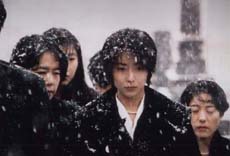Japanese Films in Korea
For many years, Japanese pop culture of any kind was banned from import into Korea, due to Japan's past colonization of Korea (1910-1945) and the at-times brutal oppression suffered by Koreans at the hands of the Japanese. As such, it was illegal for Koreans to purchase copies of Japanese movies, animation, comic books, music, or computer games, and an extensive black market developed for these items. Japanese films could only be screened at festivals such as the Pusan International Film Festival (PIFF).
 This ban lasted until 1998, when at the initiative of President Kim Dae Jung, the government began to consider opening its markets to Japanese film and other media. The announcement was met with considerable anxiety from some sectors of Korean society; in part due to fears of "cultural imperialism" (Korea's film industry in particular was considerably weaker at the time) and also due to concerns over the perceived violent and sexually-explicit nature of many Japanese films. At the time the government appointed a special committee to hear these concerns and decide on an appropriate course of action.
This ban lasted until 1998, when at the initiative of President Kim Dae Jung, the government began to consider opening its markets to Japanese film and other media. The announcement was met with considerable anxiety from some sectors of Korean society; in part due to fears of "cultural imperialism" (Korea's film industry in particular was considerably weaker at the time) and also due to concerns over the perceived violent and sexually-explicit nature of many Japanese films. At the time the government appointed a special committee to hear these concerns and decide on an appropriate course of action.
In fall of 1998, the committee announced it would implement a gradual opening of domestic markets to Japanese pop culture. The various stages of this market liberalization in terms of the film industry are listed below:
First-stage opening (October 28, 1998)
* Grand prizewinners from Cannes, Venice, Berlin or the Academy Awards Foreign Language Film Category
* Korean-Japanese co-productions (with the Korean side contributing at least 10%)
* Japanese actors and actresses permitted to act in Korean films
* Video releases permitted for all Japanese films which receive a theatrical release
The first stage opening allowed for a very limited range of films -- only those which had been awarded the grand prize at three major film festivals, or winners of the Academy Awards' Best Foreign Language Film competition. This qualified a handful of titles for release, and on December 5, 1998 Kitano Takeshi's Hana-Bi (which won the Golden Lion at the 1997 Venice Film Festival) became the first Japanese film released in Korea. It did more poorly than expected at the box-office, with only 37,771 viewers buying tickets.
The following week, Kurosawa Akira's 1982 classic Kagemusha opened and drew 57,777 admissions for the strongest performance among the first-stage films. Other films released under this stage include Imamura Shohei's Unagi (The Eel) (52,994 admissions) and The Ballad of Narayama (42,510 admissions).
Second-stage opening (September 10, 1999)
* Prizewinners from one of 70 selected film festivals
* Films rated for general audiences by Korea's Media Ratings Board
* Animated films remain off limits
 The second-stage opening, announced in September 1999, qualified a further 100 films awarded any prize at selected international film festivals, as well as any film rated for general audiences by the local censorship authority. Animated films, which draw a particular interest among Korean youth, remained forbidden. Following this announcement, Iwai Shunji's Love Letter (long popular in its pirated video version) was released on November 20, drawing an astounding 645,615 viewers, setting a box-office record for Japanese films that held until Hayao Mizakaki's Spirited Away was released in 2002.
The second-stage opening, announced in September 1999, qualified a further 100 films awarded any prize at selected international film festivals, as well as any film rated for general audiences by the local censorship authority. Animated films, which draw a particular interest among Korean youth, remained forbidden. Following this announcement, Iwai Shunji's Love Letter (long popular in its pirated video version) was released on November 20, drawing an astounding 645,615 viewers, setting a box-office record for Japanese films that held until Hayao Mizakaki's Spirited Away was released in 2002.
By the beginning of the year 2000, a considerable number of Japanese films were finding their way to Korean theaters. Some began to voice concern at this point about the burgeoning popularity of Japanese features, although by this time Korean features were also performing well at the local box-office. The release of Shall We Dance? in May was credited with a boom in local ballroom dance classes. All in all, 2000 saw the release of 25 features, which together captured an impressive 7.4% share of the local market.
Third-stage opening (June 27, 2000)
* Films rated by Korea's Media Ratings Board as 12+ or 15+
* Animated films awarded prizes at selected film festivals
* Films already granted theatrical release or those awarded prizes at selected film festivals or rated for general audiences granted access to cable and satellite TV
The third stage opening was more abrupt than many observers were expecting, granting full theatrical and video access to all live-action films except those rated 18+. Animated films were also granted permission to screen at local theaters for the first time, although they were restricted to films which had won awards at selected international festivals (qualifying about 30 features). On September 30, 2000, Ninja Scroll (1993) became the first Japanese animated feature to screen in Korea, drawing only 11,536 admissions.
Fourth-stage opening (January 1, 2004)
* Any live-action films, including films rated as 18+ or "limited release only"
* Films already granted theatrical release granted access to any kinds of media including cable, satellite and terrestrial TV.
* Animated films already granted theatrical release granted access to cable and satellite TV.
It was generally accepted that a fourth-stage opening would follow not long after the three previous stages, however in the summer of 2001 two well-publicized political events (the approval in Japan of school history textbooks judged by many outsiders to cover up past injustices, and the visit of Japanese Prime Minister Koizumi Junichiro to a shrine in which war criminals were buried) led the Korean Government to threaten indefinite suspension of Korea's opening to Japanese pop culture. Ultimately it would take until 2004 for the next stage to take place, aided by the co-operation between the two countries during the 2002 World Cup, and the Korean government's increased confidence in its own cultural products.
The fourth stage opening granted full media access to all live-action films for the first time ever. Animated films already granted theatrical release were also granted permission to screen on cable and satellite TV, although access to the theatrical market was still restricted to films which had won awards at selected international festivals. Considering their impact on teenagers and on Korea's own developing animation industry, the government announced it would delay full access for Japanese animated films until January 2006. For the first time, Japanese TV dramas were also cleared to screen on cable (but not terrestrial) TV, where they initially failed to draw much interest.
| Year | Releases | Total Admissions | Market Share |
|---|---|---|---|
| 1998 | 2 | 95,548* | 0.4% |
| 1999 | 4 | 751,837* | 3.1% |
| 2000 | 25 | 2,020,690* | 7.4% |
| 2001 | 24 | 485,688* | 1.4% |
| 2002 | 10 | 1,290,434* | 3.2% |
| 2003 | 18 | 1,341,383* | 3.0% |
| 2004 | 30 | 973,040* | 2.1% |
| 2005 | 27 | 926,083* | 2.0% |
| 2006 | 35 | 1,201,988* | 2.4% |
| 2007 | 61 | 741,939* | 1.5% |
| 2008 | 44 | 2,979,131 | 2.0% |
| 2009 | 38 | 2,679,649 | 1.7% |
| 2010 | 60 | 3,016,808 | 2.1% |
| 2011 | 50 | 2,889,991 | 1.8% |
* Note that admission figures above from 1998-2007 are the number of tickets sold in Seoul.
From 2008 onward, the figure listed is the number of tickets sold in Korea as a whole.
Source: Korean Film Council (KOFIC).
The year 2000, during which the third-stage opening took place, has been the most successful year to date for Japanese films in Korea. Hits like Bayside Shakedown, Shall We Dance?, Samurai Fiction and Poppoya: Railroad Man helped to push market share to a record 7.4%. In the following years there was an apparent waning of interest in Japanese features, although much of that was likely due to the particular features which were released. Political factors may also have come into play, particularly in 2001 as minor and major controversies led to considerable grassroots opposition against perceived nationalism in Japan. How much this has translated to lower receipts at the box-office is open to debate, however.
As in Japan itself, no Japanese director comes close to the box office pull of animator Miyazaki Hayao. His Howl's Moving Castle and Spirited Away by themselves sometimes equal or exceed the box office revenues of an entire year's worth of Japanese imports. In this sense, the yearly box office figures quoted above are heavily influenced by the work of this one man.
Since 2005, one notable development has been the strong performance of Japanese independent features. Although none appear on the chart below, films such as Josee, the Tiger and the Fish, Maison de Himiko, Tony Takitani, and Sway have been highly successful when considering the small number of theaters on which they have screened. Korean importer/distributor Sponge has been particularly successful in turning a healthy profit on such small-scale releases.
| Rank | Admissions | Release Date | |
|---|---|---|---|
| 1 | Howl's Moving Castle | 981,763 | Dec 24, 2004 |
| 2 | Spirited Away | 901,952 | Jun 28, 2002 |
| 3 | Love Letter | 645,615 | Nov 11, 1999 |
| 4 | Ponyo on the Cliff by the Sea | 472,286 | Dec 17, 2008 |
| 5 | The Borrowers | 373,176 | Sep 9, 2010 |
| 6 | Ju-on | 359,000 | Jun 27, 2003 |
| 7 | Bayside Shakedown | 300,767 | Jul 22, 2000 |
| 8 | Shall We Dance? | 300,169 | May 13, 2000 |
| 9 | The Sinking of Japan | 245,740 | Aug 31, 2006 |
| 10 | The Cat Returns | 243,220 | Aug 08, 2003 |
| 11 | Samurai Fiction | 224,256 | Feb 19, 2000 |
| 12 | Poppoya: Railroad Man | 219,327 | Feb 04, 2000 |
| 13 | Death Note | 205,035 | Nov 02, 2006 |
| 14 | Pokemon 2000: The Power of One | 185,292 | Dec 23, 2000 |
| 15 | Himitsu | 183,672 | Oct 11, 2002 |
| 16 | Crying Out For Love in the Center... | 175,002 | Oct 08, 2004 |
| 17 | Ju-on 2 | 173,000 | Sep 05, 2003 |
| 18 | April Story | 161,423 | Apr 08, 2000 |
| 19 | Death Note: Last Name | 150,881 | Jan 10, 2007 |
| 20 | Welcome Back, Mr. McDonald | 141,900 | Dec 02, 2000 |
Source: Korean Film Council (KOFIC).
Another notable development since 2002 is a number of successful Korean films set in Japan, with much of the dialogue in Japanese and key roles given to Japanese actors (these films are not included in the statistics above). Such films include 2009 Lost Memories (2002), Fighter in the Wind (2004) and Rikidozan (2004). As co-operation between the two film industries deepen, and Korean actors become more popular in Japan, such cases are likely to become more common.
(Thanks to Lee Eunhye for her assistance with this page)